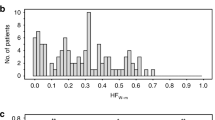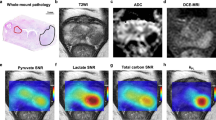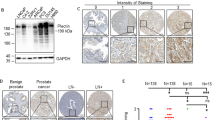Abstract
Tumour hypoxia is associated with over 70% of solid tumours including prostate and colorectal cancer. Hypoxia promotes tumour progression and resistance to treatment. Carbonic anhydrase IX (CA IX) is an endogenous marker of hypoxia. It is expressed in lung and renal cell carcinomas and is associated with a poor prognosis. CA IX has an important role in maintaining pH levels in the highly metabolically active cancer cell. The expression of CA IX in prostate cancer has not previously been investigated. Immunohistochemistry was used to examine CA IX expression in 59 patients, using tissue microarrays (TMAs) and full sections of BPH, surrounding stroma and prostate adenocarcinoma. Cores reviewed included 189 BPH, 130 Gleason grade 3, 93 Gleason grade 4, 40 Gleason grade 5. CA IX expression in colorectal cancer and HIF 1α in prostate cancer acted as positive controls. There was only occasional cell staining for CA IX expression. Although prostate cancer is a hypoxic tumour it does not express CA IX. This implies it relies on alternative pathways for maintaining pH balance in cancer. These studies would indicate that CA IX is not a suitable marker of hypoxia in prostate cancer.
This is a preview of subscription content, access via your institution
Access options
Subscribe to this journal
Receive 4 print issues and online access
$259.00 per year
only $64.75 per issue
Buy this article
- Purchase on Springer Link
- Instant access to full article PDF
Prices may be subject to local taxes which are calculated during checkout

Similar content being viewed by others
References
Vaupel P . Hypoxia in breast cancer: Pathogenesis, characterisation and biological/therapeutic implications. Wiener Medizinische Wochenschrift 2002; 152, pp 334–342.
Marginol L, Coffey M, Lawlor M, Hollywood D . Hypoxia in prostate cancer: a powerful shield against tumour destruction? Cancer Treat Rev 2008; 34, pp 313–327.
Hoeckel M, Vaupel P . Biological consequences of tumour hypoxia. Semin Oncol 2001; 28, pp 26–41.
Harris A . Hypoxia a key regulatory factor in tumour growth. Nat Rev Cancer 2002; 2, pp 38–47.
Vergis R, Corbishley CM, Norman AR, Bartlett J, Jhavar S, Borre M et al. Intrinsic markers of hypoxia and angiogenesis in localised prostate cancer and outcome of radical treatment: a retrospective analysis of two randomised radiotherapy trials and one surgical cohort study. Lancet Oncol 2008; 9, pp 342–351.
Sherwood B, Colquhoun AJ, Richardson D, Bowman KJ, O’Byrne KJ, Kockelbergh RC et al. Carbonic anhydrase IX expression and outcome after radiotherapy for muscle-invasive bladder cancer. Clin Oncol (R Coll Radiol) 2007; 19, pp 777–783.
Swinson D, Jones JL, Richardson D . Carbonic anhydrase IX expression, a novel surrogate marker of tumour hypoxia, is associated with a poor prognosis in non-small- cell lung cancer. J Clin Oncol 2003; 21, pp 473–482.
Bui M, Seligson D, Han KR, Pantuck AJ, Dorey FJ, Huang Y et al. Carbonic anhydrase IX is an independent predictor of survival in advanced renal clear cell carcinoma: implications for prognosis and therapy. Clin Cancer Res 2003; pp 802–811.
Schrijvers M, van der Laan BF, de Bock GH, Pattje WJ, Mastik MF, Menkema L et al. Overexpression of intrinsic hypoxic markers HIF 1 alpha and CA IX predict for local recurrence in stage T1-T2 glottic laryngeal carcinoma treated with radiotherapy. Int J Radiat Oncol Biol Phys 2008; 72, pp 161–169.
Sennoune S, Luo D, Martinez-Zaguilam R . Plasma-lemmal vacuolar-type H+-ATPase in cancer biology. Cell Biochem Biophys 2004; pp 185–206.
Nishi T, Forgac M . The vacuolar (H)-ATPases- nature's most versatile proton pumps. Nature Rev Mol Cell Biol 2002; pp 94–103.
Sennoune S, Bakunts K, Martinez GM . Vacuolar H+-ATPase in human breast cancer cells with distinct metastatic potential: distribution and functional activity. Am J Physiol Cell 2004; 286, pp 1443–1452.
Potter C, Harris AL . Hypoxia inducible carbonic anhydrase IX, marker of tumour hypoxia, survival pathway and therapy target. Cell Cycle 2004; pp 164–167.
Saarnio J, Parkkila S, Parkkila AK . Immunohistochemistry of carbonic anhydrase isozyme in human gut reveals polarised expression in the epithelial cells with the highest proliferative capacity. Cytochem 1998; 46, pp 497–504.
Zavada J, Zadadova Z, Pastorek J, Biesova Z, Jezek J, Velek J . Human tumour- associated cell adhesion protein MN/CA IX: identification of M 75 epitope and of the region mediating cell adhesion. Br J Cancer 2000; 82, pp 1808–1813.
Svastova E, Zilka N, Zat′ovicova M, Gibadulinova A, Ciampor F, Pastorek J . Carbonic anhydrase IX reduces E-cadherin-mediated adhesion of MDCk cells via interaction with beta-catenin. Exp Cell Res 2003; 290, pp 332–345.
Robertson N, Potter C, Harris AL . Role of carbonic anhydrase IX in human tumour cell growth, survival and invasion. Cancer Res 2004; 64, pp 6160–6165.
Parkkila S . Significance of pH regulation and carbonic anhydrases in tumour progression and implications for diagnostic and therapeutic approaches. BJU Int 2008; (Supp 4): pp 16–21.
Winum J, Innocenti A, Scozzafava A, Montero JL, Supuran CT . Carbonic anhydrase inhibitors. Inhibition of the human cytosolic isoforms I and II and transmembrane, tumor-associated isoforms IX and XII with boronic acids. Bioorg Med Chem 2009; 17, pp 3649–3652.
Klatte T, Belldegrun AS, Pantuck AJ . The role of carbonic anhydrase IX as a molecular maker for transitional cell carcinoma of the bladder. BJU Int 2008; 101 (Supp 4): pp 45–48.
Belldegrun A, Bevan P . Carbonic anhydrase IX: role in the diagnosis and cancer therapy. Introduction. BJU Int 2008; 101 (Supp 4): pp 1.
Said J . Biomarker discovery in urogenital cancer. Biomarkers 2005; 10, pp 83–86.
Rasheed S, Harris AL, Tekkis PP, Silver A, McDonald PJ, Talbot IC et al. Assessment of microvessel denisty and carbonic anhydrase- 9 CA-9 expression in rectal cancer. Pathol Res Pract 2009; 205, pp 1–9.
Parker C, Milosevic M, Toi A, Sweet J, Panzarella T, Bristow R et al. Polargraphic electrode study of tumour oxygenation in clinically localised prostate cancer. Int J Radiat Oncol Biol Phys 2004; 58, pp 750–757.
Lekas A, Lazaris AC, Deliveliotis C, Chrisofos M, Zoubouli C, Lapas D et al. The expression of hypoxia-inducible factor- 1alpha and angiogenesis in hyperplastic and malignant prostate tissue. Anticancer 2006; 26, pp 2989–2993.
Forgac M . Vacuolar ATPases: rotary proton pumps in physiology and pathophysiology. Nature Rev/Mol Cell Biol 2007; 8, pp 917–929.
Jefferies K, Cipriano DJ, Forgac M . Function, structure and regulation of the vacuolar (H)- ATPases. Arch Biochem and Biophysics 2008; 476, pp 33–42.
Herak-Kramberger C, Breton S, Brown D, Kraus O, Sabolic I . Distribution of the vacuolar H+ ATPase along the rat and human male reproductive tract. Biol Reprod 2001; 64, pp 1699–1707.
Stock C, Schwab A . Protons make tumour cells move like clockwork. Plfugers Arch 2009.
Halestrap A, Meredith D . The SLC 16 gene family fafrom monocarboxylate transporters (MCTs) to aromatic amino acid transporters and beyond. Plfugers Arch 2004; 447, pp 619–628.
Halestrap A, Price NT . The proton linked monocarboxylate transporter (MCT) family: structure, function and regulation. Biochem J 1999; 343, pp 281–299.
Ord J, Streeter EH, Roberts IS, Cranston D, Harris AL . Comparison of hypoxia in vitro with in vivo gene expression in human bladder cancer. Br J Cancer 2005; 93, pp 346–354.
Acknowledgements
This study was supported by individual grants from the British Urological Foundation and the Joint RCSI/UCD Surgical Research Grant Incorporating the Gussie Mehigan Scholarship. We thank Professor Adrian Harris, Molecular Oncology laboratories, University of Oxford for the gift of the M75 antibody.
Author information
Authors and Affiliations
Corresponding author
Ethics declarations
Competing interests
The authors declare no conflict of interest.
Rights and permissions
About this article
Cite this article
Smyth, L., O'Hurley, G., O'Grady, A. et al. Carbonic anhydrase IX expression in prostate cancer. Prostate Cancer Prostatic Dis 13, 178–181 (2010). https://doi.org/10.1038/pcan.2009.58
Received:
Accepted:
Published:
Issue Date:
DOI: https://doi.org/10.1038/pcan.2009.58
Keywords
This article is cited by
-
Chronic hypoxia favours adoption to a castration-resistant cell state in prostate cancer
Oncogene (2023)
-
Genetic polymorphisms in key hypoxia-regulated downstream molecules and phenotypic correlation in prostate cancer
BMC Urology (2017)
-
Carbonic anhydrase IX is a marker of hypoxia and correlates with higher Gleason scores and ISUP grading in prostate cancer
Diagnostic Pathology (2016)
-
Immunohistochemical expression of PDGFR, VEGF-C, and proteins of the mToR pathway before and after androgen deprivation therapy in prostate carcinoma: significant decrease after treatment
Targeted Oncology (2014)
-
Investigation on tumor hypoxia in resectable primary prostate cancer as demonstrated by 18F-FAZA PET/CT utilizing multimodality fusion techniques
European Journal of Nuclear Medicine and Molecular Imaging (2011)



